Humans Might Not Be The Only Creatures That Care About The Welfare Of Other Animals. Scientists Are Beginning

Humans might not be the only creatures that care about the welfare of other animals. Scientists are beginning to recognize a pattern in humpback whale behavior around the world, a seemingly intentional effort to rescue animals that are being hunted by killer whales.
Marine ecologist Robert Pitman observed a particularly dramatic example of this behavior back in 2009, while observing a pod of killer whales hunting a Weddell seal trapped on an ice floe off Antarctica. The orcas were able to successfully knock the seal off the ice, and just as they were closing in for the kill, a magnificent humpback whale suddenly rose up out of the water beneath the seal.
This was no mere accident. In order to better protect the seal, the whale placed it safely on its upturned belly to keep it out of the water. As the seal slipped down the whale’s side, the humpback appeared to use its flippers to carefully help the seal back aboard. Finally, when the coast was clear, the seal was able to safely swim off to another, more secure ice floe.
Read more
Read the study: Humpback whales interfering when mammal-eating killer whales attack other species: Mobbing behavior and interspecific altruism?
More Posts from Llamaslikesciencetoo and Others
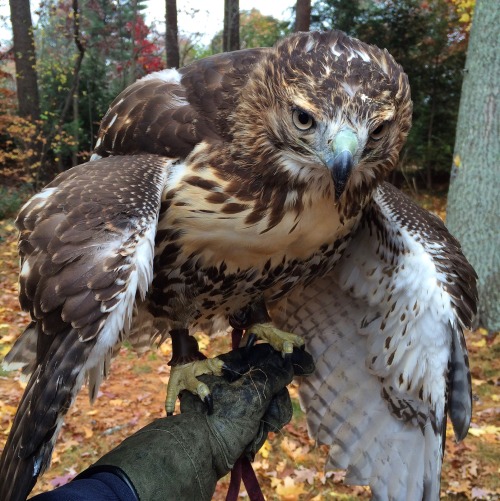
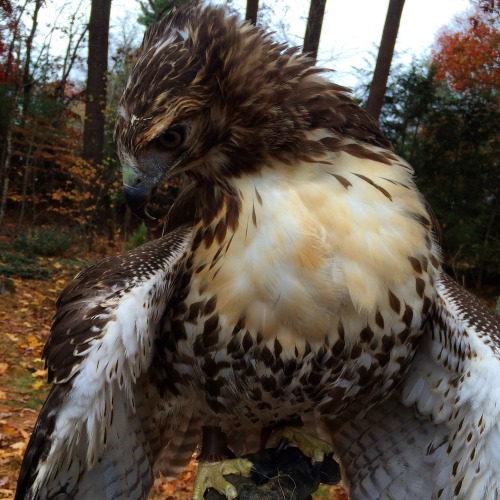
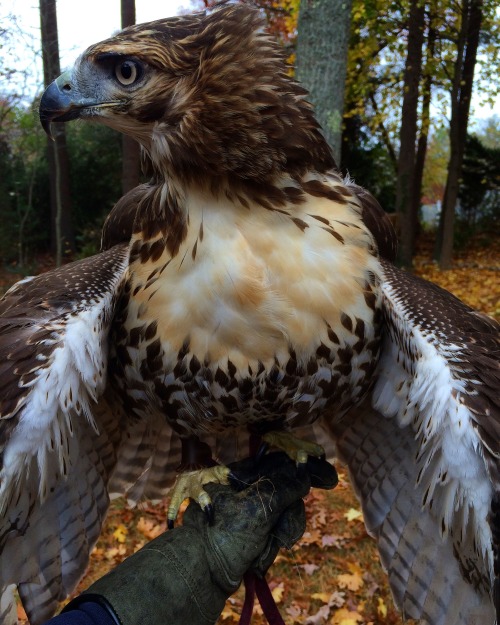
dragon 🐉


The Mud Dragons of Calvert Island, BC
Shedding light on these mysterious marine creatures.
by Josh Silberg
Spiky headed dragons roam the ocean floor from the poles to the tropics. But these are not winged beasts from the pages of science fiction. These strange creatures are Kinorynchs, aka “mud dragons“, and they are very real.
Roughly the size of a grain of salt, mud dragons are often overlooked, but a team from the Hakai Institute and the University of British Columbia (UBC) hopes to give them the spotlight they deserve.
“Canada has very few reports on these animals. The first step is to know what is there,” says Dr. Maria Herranz, a Hakai post-doctoral scholar and resident mud dragon expert at UBC…
(read more and see video: Hakai)
images by Marria Harranz
It’s Jehol Biota Day!
The Jehol Biota is the ecosystem of the Yixian and Jiofotang Formations of northeastern China, dating between 133 and 120 million years ago in the Early Cretaceous (from the Valanginian to Aptian ages).
It is famous because of it’s method of preservation - there were ash eruptions periodically, and the fossils are Lagerstätten, meaning that they were exceptionally well preserved with articulated skeletons, soft tissues, stomach contents, and even coloration.
This has led to an amazing understanding of various types of dinosaurs and other prehistoric animals, especially very birdy dinosaurs.
These animals lived in forests around lakes, dominated by conifers but featuring the earliest flowering plants - Archaefructus, which may have been a water plant.

By Shizhao, CC BY-SA 2.5
There were dry seasons, but it was a mostly wet formation, as many of the plants grew in very wet habitats and probably stayed close to bodies of water.
The Yixian Formation was the older of the two main Jehol Formations, and featured many, many animals. Of invertebrates, there were spiders, crustaceans, dragonflies, flies, wasps, many other insects, and molluscs, of too many to list. Fish included the lamprey Mesomyzon, ray finned fishes such as Lycoptera, Peipiaosteus, Protopsephurus, Sinamia, and Yanosteus, and a potential shark. There were frogs and toads like Callobatrachus, Liaobatrachus, and Mesophryne, as well as a salamander, Liaoxitriton.

Callobatrachus by Emily Willoughby, CC BY-SA 3.0
There were mammals, too, of course - the stem-placental Acristatherium, the stem-marsupials Akidolestes, Maotherium, Zhangheotherium, and Sinodelphys, the stem-therian (Therians being the group of Marsupials and Placentals) Eomaia, the multituberculate (a group of mammals which seem to also be stem-therians) Sinobaatar, and a significant number of Eutriconodonts, a group of early derived mammals, including Chaoyangodens, Gobiconodon, Jeholodens, Juchilestes, Meemannodon, Repenomamus, and Yanoconodon.

Eomaia by Nobu Tamura, CC BY-SA 3.0
There were the weird early derived Saurians (the group consisting of Lepidosauromorphs and Archosauromorphs, so Extant Reptiles), Choristoderans - Hyphalosaurus, which is known from thousands of specimens, and Monjurosuchus. Lizards included Dalinghosaurus, similar to the modern Chinese Crocodile Lizard; Liushusaurus and Yabeinosaurus, lizards relatedx to modern geckos and skinks, and Xianglong, a gliding lizard. Turtles included Manchurochelys and Ordosemys, both Cryptodirans, a group including giant tortoises, sea turtles, tortoises, snapping turtles, and others.

Hyphalosaurus by Matt Martyniuk, CC BY 3.0

Xianglong by Nobu Tamura, CC BY 3.0
The heroes of the formation were, of course, the Avemetatarsalians. There were many pterosaurs - Beipiaopterus, Boreopterus, Cathayopterus, Elanodactylus, Eosipterus, Feilongus, Gegepterus, Gladocephaloideus, Haopterus, Moganopterus, Ningchengopterus, Pterofiltrus, and Zhenyuanopterus.

Ningchengopterus by Nobu Tamura, CC BY 3.0
Ornithischians included the ornithopods Bolong, Jeholosaurus, and Jinzhousaurus, the ankylosaur Liaoningosaurus, and the ceratopsians Liaoceratops and Psittacosaurus. There were sauropods too - the titanosauriform Dongbeititan, a potential titanosaur, and an animal that has for now been referred to Euhelopus. But the real heavyweights were the theropods.

Jeholosaurus by @ryuukibart
There were the tyrannosauroids Yutyrannus - one of the best known tyrannosauroids with feathers - and Dilong; the compsognathus Huaxiagnathus, Sinocalliopteryx, and Sinosauropteryx - the first non-avian dinosaur known to have feathers, and also with known coloration; early Ornithomimosaurs such as Hexing and Shenzhousaurus; the early derived maniraptoran Yixianosaurus; Beipiaosaurus, a therizinosaur; and tons of Chickenparrots, such as Similicaudipteryx, Protarchaeopteryx, Ningyuansaurus, Incisivosaurus, and Caudipteryx.

Yutyrannus, model from “Dinosaurs Among Us”, photo by me

Sinosauropteryx by Matt Martyniuk, CC BY-SA 3.0
There were many Dromaeosaurids (raptors), such as Graciliraptor, Tianyuraptor, Zhenyuanlong - a raptor known from nearly complete feather traces, including extremely large wings - and Sinornithosaurus, the first Dromaeosaurid found with feathers. There were also lots of Troodontids, such as Sinusonasus, Sinovenator, and Mei, as well as unnamed members of both groups. There were early-derived Avialans such as Zhongornis, Jixiangornis, Confuciusornis, and Changchengornis. There were loads of Enantiornithines, such as Bohaiornis, Eoenantironis, Dalingheornis, Liaoningornis, Longirostravis, and Shanweiniao - an Enantiornithine that had a tail fan like modern birds. There were also Euornithines - the group which contains modern birds - such as Longicrusavis, Hongshanornis, and Archaeorhynchus. In short, this was an extremely birdy formation indeed.

Zhenyuanlong by Emily Willoughby, CC BY-SA 4.0

Shanweiniao by Nobu Tamura, CC BY 3.0
The Jiuofotang Formation was slightly younger, but was similar to the Yixian in terms of the animals there. There were ray finned fishes such as Jinanichthys, Lycoptera, Peipiaosteus, Protsephurus, and Sinamia. There was the mammal Liaoconodon, a Eutriconodont, as well as an unnamed mammal similar to Eomaia from the Yixian Formation. There were also Choristoderans like Philydrosaurus, Ikechosaurus, and Liaoxisaurus.

Liaoconodon by Dylan Bajda, CC BY-SA 4.0
There were many, many, many pterosaurs. This included Chaoyangopterus, Eoazhdarcho, Guidraco, Ikrandraco, Jidapterus, Liaoningopterus, Liaoxipterus, Linlongopterus, Nemicolopterus, Nurhachius, Shenzhoupterus, and Sinopterus. And, as we shall see, there were a lot of flying theropods as well, indicating that the two groups did live alongside one another just fine, and the common narrative of “birds replaced pterosaurs” has little foundation in the fossil record.

Ikrandraco, by Fabrizio De Rossi, from www.pteros.com

Chaoyangopterus, by Joschua Knüppe, from www.pteros.com
There were only a few Ornithischians - namely Chuanqilong, an ankylosaur, and Psittacosaurus, a ceratopsian. There is also an unnamed titanosaur from the formation. As for theropods, there were a lot. The tyrannosauroid Sinotyrannus was the largest predator there, there was the Chickenparrot Similicaudipteryx, and of course one of the most famous raptors, Microraptor, which was a four-winged Dromaeosaurid that we know had iridescent black feathers.

Microraptor by @artisticthingem
There were many early derived Avialans, such as Confuciusornis, Dalianraptor, Omnivoropteryx, Sapeornis, Shenshiornis, Zhongjianornis, and my personal favorite, Jeholornis, a theropod we know was a seed-eater, which is actually quite hard to determine from fossils. There were many Enantiornithines, such as Alethoalaornis, Boluochia, Cathayornis, Cuspirostrisornis, Dapingfangornis, Eocathayornis, Gracilornis, Huoshanornis, Largirostrornis, Longchengornis, Longipteryx, Rapaxavis, Xiangornis, and one of my favorites, Sinornis, which is thought to have perched. As for Euornithines, there was Chaoyangia, Jianchangornis, Parahongshanornis, Schizooura, Songlingornis, Yanornis, and Yixianornis.

Jeholornis by Matt Martyniuk, CC BY-SA 3.0

Sinornis, by Pavel Rhia, CC BY-SA 3.0
It’s plain to see why the Jehol Biota is so fascinating. At least for me, I love it because it’s clearly one of the best pictures we have of Pennaraptoran evolution - the amount of birdie dinosaurs is absolutely ridiculous. But there’s really something for everyone here - there are titanosaur-like things, some of the earliest Ceratopsians, tons of Pterosaurs, weird Choristoderans, and even some insights into the evolution of early mammals and different types of amphibians and fish, as well as the first flowering plants. The Jehol Biota is one of the best ecosystems we know about, and it definitely deserves celebration!
Sources:
https://en.wikipedia.org/wiki/Jehol_Biota
https://en.wikipedia.org/wiki/Jiufotang_Formation
https://en.wikipedia.org/wiki/Yixian_Formation

SPERM WHALE EVOLVED TO RAMMING
Herman Melville’s novel Moby Dick was inspired by historical instances in which large sperm whales (Physeter macrocephalus L.) sank 19th century whaling ships by ramming them with their foreheads. The immense forehead of sperm whales is possibly the largest, and one of the strangest, anatomical structures in the animal kingdom. It contains two large oil-filled compartments, known as the “spermaceti organ” and “junk,” that constitute up to one-quarter of body mass and extend one-third of the total length of the whale
Now an international team of researchers used structural engineering principles to test how the head of the sperm whale might be able to resist strong ramming impacts. Using computer simulations and working from published data on sperm-whale tissue and skeletal structure, scientists modeled impacts of varying types, and from a range of directions,what they found is the whale’s junk proved to play a vital role, with tissue partitions distributing much of the stress from ramming impacts and thereby preventing the skull from fracturing.
Although male sperm whales may not fight frequently, we know that aggressive ramming behaviour is a common characteristic in the group of mammals from which whales are derived – the even-toed ungulates, the artiodactyls.
Illustration: Schematic representation of sperm whale head structure, courtesy of Ali Nabavizadeh.
Reference: Panagiotopoulou et al. 2016. Architecture of the sperm whale forehead facilitates ramming combat Peerj

Sawfish sharks,of the order (Pristiformes) of rays characterized by a long, narrow, flattened rostrum, or nose extension, lined with sharp transverse teeth, arranged so as to resemble a saw. All species of sawfish are endangered or critically endangered due to over fishing or habitat loss.
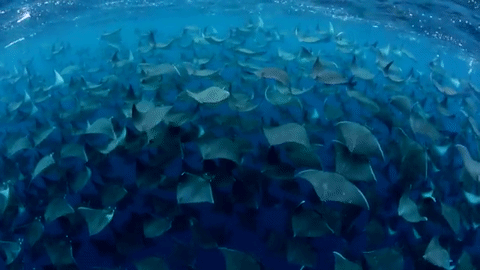
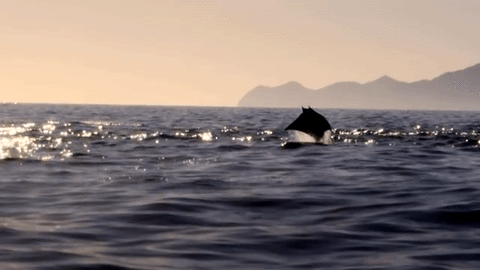
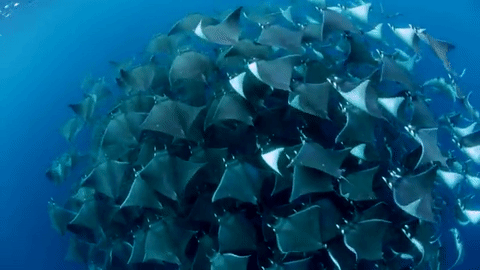

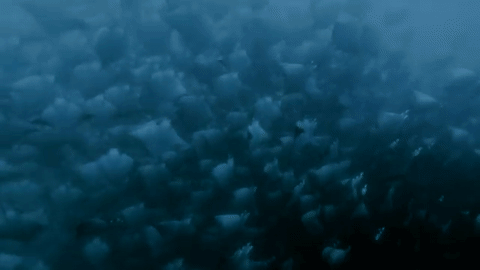
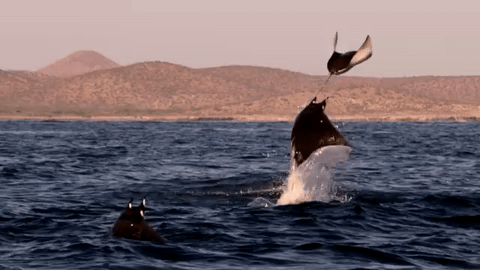
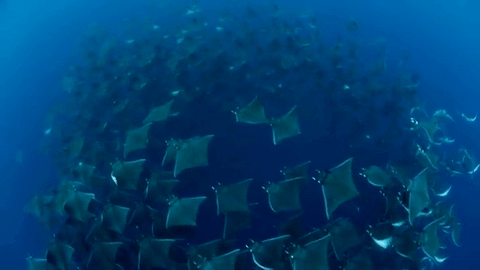
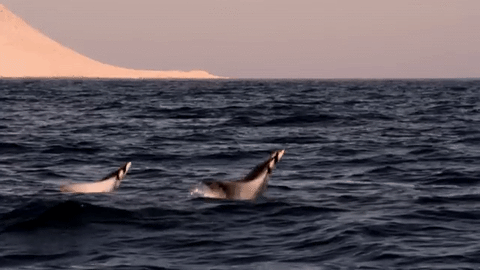
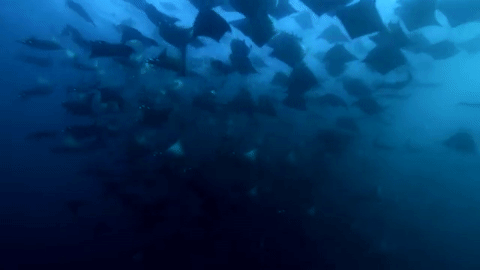
closely related to sharks but with long, flat bodies and wing-like pectoral fins, mobula rays are ideally suited to swooping through the water - here off the gulf of california - yet seem equally at home in the air, so much so that they have earned the name “flying rays”. mobula rays can reach heights of more than two metres, remaining airborne for several seconds.
mobula rays are quite elusive and difficult to study, so biologists are not quite sure why they jump out of the water. theories vary from a means of communication, to a mating ritual (though both males and females jump), or as a way to shed themselves of parasites. they could also be jumping as a way of better corralling their pray, as seen with them swimming in a circular formation.
what is known about mobula rays is that they reach sexual maturity late and their investment in their offspring is more akin to mammals than other fishes, usually producing just a single pup after long pregnancies, all of which makes them extremely vulnerable to commercial fishing, especially as a species that likes to come together in large groups.

An animated chart of 42 North American butterflies
Via Tabletop Whale

The human brain in comparison with those of other animals. The diverse yet unified pattern of nature never fails to amaze me.
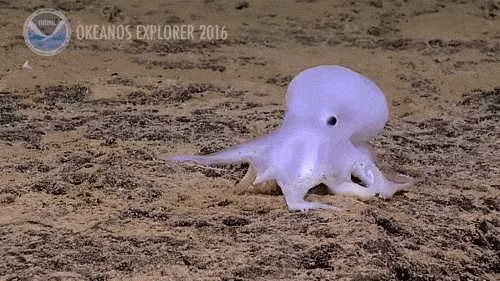

The Okeanos Explorer has discovered a very cute octopus at a depth of 4,290 metres.
This is the deepest an octopus of this particular sub order of octopus has ever been seen.
The National Oceanic and Atmospheric Administration noted this is a completely unsubscribed species and perhaps not belonging to any specific genus. Highlighting how little we still know about the creatures in the depths of our oceans.
(Ocean Explorer)








Episode 46 of the In Defense of Plants Podcast has arrived!
This week its all about the flora of the Ozarks!
The Ozark Mountains have long been a mystery to me. This ancient mountain range is home to a bewildering diversity of plant life, some of which is found nowhere else in the world. From glades to woodlands and everything in between, the Ozarks have it all. Join me for a discussion with Justin Thomas, director of the Institute of Botanical Training. Justin and his wife have devoted their lives to studying and protecting the plants of this region. I learned a lot from talking with Justin and I know you will too.
Photos by Justin Thomas
-
 saphicspacesociety18 reblogged this · 1 year ago
saphicspacesociety18 reblogged this · 1 year ago -
 des8pudels8kern reblogged this · 1 year ago
des8pudels8kern reblogged this · 1 year ago -
 thedragonboi reblogged this · 1 year ago
thedragonboi reblogged this · 1 year ago -
 thedragonboi liked this · 1 year ago
thedragonboi liked this · 1 year ago -
 raqstarnails liked this · 2 years ago
raqstarnails liked this · 2 years ago -
 bates--boy reblogged this · 3 years ago
bates--boy reblogged this · 3 years ago -
 bates--boy liked this · 3 years ago
bates--boy liked this · 3 years ago -
 pricklydyke liked this · 4 years ago
pricklydyke liked this · 4 years ago -
 rchatonne liked this · 4 years ago
rchatonne liked this · 4 years ago -
 perfect-exposure reblogged this · 4 years ago
perfect-exposure reblogged this · 4 years ago -
 little-parade liked this · 4 years ago
little-parade liked this · 4 years ago -
 artemisarticles reblogged this · 5 years ago
artemisarticles reblogged this · 5 years ago -
 hannahisbby reblogged this · 5 years ago
hannahisbby reblogged this · 5 years ago -
 hannahisbby liked this · 5 years ago
hannahisbby liked this · 5 years ago -
 lillpeanutt liked this · 5 years ago
lillpeanutt liked this · 5 years ago -
 surfinggrimreaper reblogged this · 5 years ago
surfinggrimreaper reblogged this · 5 years ago -
 surfinggrimreaper liked this · 5 years ago
surfinggrimreaper liked this · 5 years ago -
 reignandco liked this · 5 years ago
reignandco liked this · 5 years ago -
 exhaustedlesbeam liked this · 5 years ago
exhaustedlesbeam liked this · 5 years ago -
 macaroni-rascal reblogged this · 5 years ago
macaroni-rascal reblogged this · 5 years ago -
 a-cool-potato liked this · 5 years ago
a-cool-potato liked this · 5 years ago -
 ablueeyedarcher liked this · 5 years ago
ablueeyedarcher liked this · 5 years ago -
 janestvalentine reblogged this · 6 years ago
janestvalentine reblogged this · 6 years ago -
 janestvalentine liked this · 6 years ago
janestvalentine liked this · 6 years ago -
 fiveratsinabodysuit liked this · 6 years ago
fiveratsinabodysuit liked this · 6 years ago -
 sleepygrumpylumpy reblogged this · 6 years ago
sleepygrumpylumpy reblogged this · 6 years ago -
 hawkrose14 liked this · 6 years ago
hawkrose14 liked this · 6 years ago -
 myrskyisaa liked this · 6 years ago
myrskyisaa liked this · 6 years ago -
 tvshowswillruinmylife reblogged this · 6 years ago
tvshowswillruinmylife reblogged this · 6 years ago -
 milverton reblogged this · 6 years ago
milverton reblogged this · 6 years ago -
 dreaminblue67 liked this · 6 years ago
dreaminblue67 liked this · 6 years ago -
 silver9mm reblogged this · 6 years ago
silver9mm reblogged this · 6 years ago -
 sadunicornsdance liked this · 6 years ago
sadunicornsdance liked this · 6 years ago -
 nonesensedreferences reblogged this · 6 years ago
nonesensedreferences reblogged this · 6 years ago -
 ipagem liked this · 6 years ago
ipagem liked this · 6 years ago -
 alibabie liked this · 6 years ago
alibabie liked this · 6 years ago -
 liarmonstersnappydresser liked this · 7 years ago
liarmonstersnappydresser liked this · 7 years ago
Mainly interested in ecology, but also the entirety of science.
179 posts